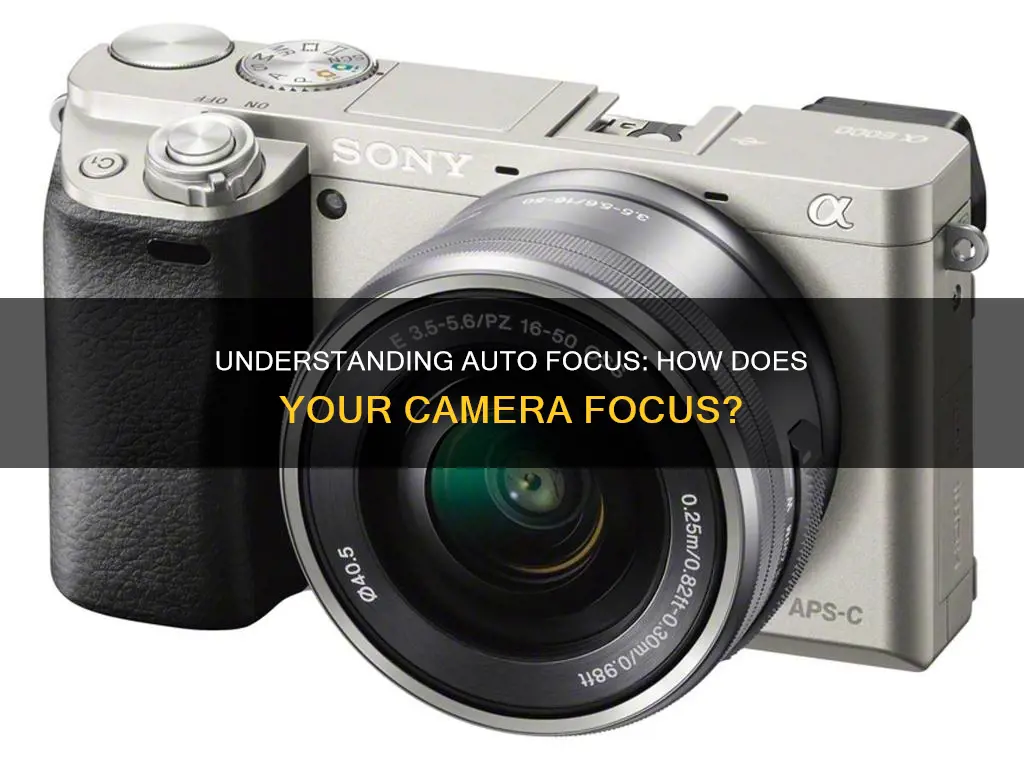
Autofocus (AF) is a feature on cameras that automatically focuses on the subject matter in the frame. It works by using autofocus zones, which are meant to be user adjustable for different uses such as auto face recognition or focusing on the dead centre of the frame. The camera's software looks for a crisp line inside the focus zone and makes adjustments until the image is as sharp as possible. Autofocus systems can be divided into two types: active and passive. Active AF emits a signal to illuminate or estimate the distance to the subject, while passive AF uses contrast sensors within the camera to achieve accurate autofocus.
| Characteristics | Values |
|---|---|
| Type | Active and passive |
| Working | Uses a computer to run a miniature motor that focuses the lens |
| Active AF | Emits a signal to illuminate or estimate the distance to the subject |
| Passive AF | Analyses the image itself to determine the distance to the subject |
| Active AF limitations | May not work if the subject is not in the middle |
| Passive AF limitations | Requires light and image contrast to function |
| Active AF advantage | Works in the dark |
| Passive AF advantage | No distance-to-subject limitation |
What You'll Learn

Active vs. Passive Autofocus
There are two types of autofocus (AF) systems: active and passive. The main difference between the two is that active AF systems measure distance to the subject independently of the optical system, whereas passive AF systems determine correct focus by performing passive analysis of the image that is entering the optical system.
Active Autofocus
Active AF systems work by emitting a signal, such as a red beam of light or infrared light, and bouncing it off the subject to calculate the distance between the camera and the subject. Once the camera knows the distance, it instructs the lens to adjust its focus accordingly. Active AF can be used in low-light environments and with stationary subjects, but it is not suitable for moving subjects and can only be used for subjects that are relatively close to the camera.
Passive Autofocus
Passive AF systems, on the other hand, do not rely on emitting a signal to calculate the distance to the subject. Instead, they use "Phase Detection" or "Contrast Detection" methods to detect contrast. Passive AF systems analyse the image for areas of high contrast, which they use as a reference point to adjust the focus. Passive AF requires light and image contrast to function properly and does not work well in low-light conditions or with subjects that have little detail or are uniformly coloured.
Hybrid Autofocus
A hybrid autofocus system combines two or more autofocus methods, such as active and passive methods or phase detection and contrast measurement, to improve the overall reliability, accuracy, and speed of the autofocus function.
CR123A Batteries: How Long Do They Power Cameras?
You may want to see also

Autofocus Sensors
The autofocusing process generally involves an autofocus processor (AFP) making small changes to the focusing distance, reading the AF sensor to assess whether focus has improved, and then setting the lens to a new focusing distance. This process may be repeated several times until satisfactory focus is achieved, usually within a fraction of a second. However, in some cases, the camera may fail to achieve focus, resulting in the "focus hunting" scenario where the camera repeatedly adjusts back and forth without achieving a focus lock.
The number and type of autofocus sensors vary across different camera models. High-end SLR cameras can have 45 or more autofocus points, while some cameras may have as few as one central AF point. The robustness and flexibility of autofocus depend on the number, position, and type of autofocus points available.
It is worth noting that compact digital cameras often use the image sensor itself as a contrast sensor, and they may not have multiple discrete autofocus sensors like those found in cameras using the phase detection method of autofocus.
Droid Turbo: Accessing Camera Shooting Modes
You may want to see also

Factors Affecting Autofocus Performance
Several factors can affect the performance of autofocus (AF) in a camera. Here are some of the key factors:
- Light Level: The amount of light available can significantly impact AF performance. Low-light conditions can make it tougher for the camera to detect contrast, which is essential for accurate focusing.
- Subject Contrast: AF systems rely on areas of high contrast to function properly. A scene with distinct features, sharp edges, or pronounced textures provides better autofocus performance.
- Camera or Subject Motion: AF performance can be influenced by the movement of the camera or the subject being captured. Continuous AF modes are designed to track moving subjects and predict their future positions, making them suitable for action photography.
- Number and Type of Autofocus Points: Different camera models offer varying numbers and layouts of autofocus points. Higher-end cameras may have 45 or more AF points, while others may have as few as one central point. Cross-type sensors, which detect contrast in two dimensions, offer higher accuracy than vertical line sensors.
- Lens Maximum Aperture: The lens maximum aperture plays a crucial role in AF performance. Aperture values of f/2 to f/2.8 are generally considered optimal for both focusing speed and accuracy. Professional camera models can often work with smaller apertures like f/8, which is advantageous when using teleconverters.
- Focus Detection Range: The focus detection range determines the camera's sensitivity to low-light conditions. Newer cameras often feature a wider focus detection range, enabling reliable focusing even in extremely dark environments.
- Speed of Focus Motors: The speed of the focus motors in the camera and lens can impact AF performance. Older lenses tend to have slower screw-drive AF motors, while newer lenses incorporate faster and quieter linear or silent-wave motors.
- Active or Passive AF: Active AF systems emit a signal or beam to estimate the distance to the subject and are useful in low-light conditions. Passive AF systems, on the other hand, rely on contrast detection or phase detection methods and perform better when there is sufficient light and contrast in the scene.
The Science of Camera Sensors: How Are They Made?
You may want to see also

Number and Type of Autofocus Points
The number and type of autofocus points play a crucial role in achieving accurate and consistent focus in photography. Let's delve into the details of autofocus points and explore why they are essential for capturing sharp images.
Understanding Autofocus Points
Autofocus points, often denoted as AF points, are the areas in the camera's viewfinder that the camera can choose to focus on. These points are usually represented as rectangles or circles. The more autofocus points a camera has, the more areas it can focus on, providing greater flexibility in composing your shots.
The Significance of Autofocus Point Count
The number of autofocus points impacts your ability to capture moving subjects and off-centre compositions. A higher number of autofocus points means you have more options to select the desired area of focus, making it easier to track and maintain focus on a moving subject. This is particularly advantageous for wildlife or sports photography, where your subjects are often in motion.
Additionally, having a larger number of autofocus points allows for more precise focusing when your subject is not centred in the frame. With fewer autofocus points, you might encounter challenges in achieving accurate focus when your subject is positioned away from the centre, as the autofocus system may struggle to lock onto the desired area.
Types of Autofocus Points
There are three main types of autofocus points: vertical, horizontal, and cross-type. Vertical AF points detect contrast on vertical lines, while horizontal AF points do the same for horizontal lines. Cross-type AF points, on the other hand, analyse both vertical and horizontal lines together, making them more accurate and capable of retaining focus better.
Cross-type AF points are commonly found in higher-end DSLR cameras, and their presence is one of the reasons why more expensive cameras tend to have better autofocus systems. When choosing a camera, consider not only the number of autofocus points but also the proportion of cross-type AF points, as they contribute significantly to the overall autofocus performance.
Selecting Autofocus Points
Most modern DSLR cameras offer the option to manually select the autofocus points. This feature is particularly useful when you want to have precise control over the area of focus or when the autofocus system struggles to detect the subject automatically. By manually choosing the autofocus points, you can ensure that the camera focuses on the desired area, resulting in sharper images.
Final Thoughts
Understanding the number and type of autofocus points is essential for harnessing the full potential of your camera's autofocus system. By knowing how these autofocus points work and how to utilise them effectively, you can capture stunning images with precise focus, even in challenging situations involving moving subjects or off-centre compositions.
Understanding Bulb Exposure Mode in Photography
You may want to see also

Autofocus Modes
Autofocus is a feature on most cameras today. It works by intelligently adjusting the camera lens to obtain focus on the subject, resulting in a sharp image. Autofocus systems have improved over the last decade, with even cheap cameras now equipped with rather complex algorithms capable of automatically scanning the scene and identifying the subject.
There are two types of autofocus (AF) systems: active and passive. Active AF works by projecting a red beam onto the subject and then bouncing that light back to the camera to calculate the distance between the camera and the subject. Passive AF, on the other hand, uses either phase detection or contrast detection to determine the distance to the subject by analysing the image itself.
There are four primary autofocus modes: Continuous, Single, Automatic, and Manual. Continuous mode is useful for keeping moving objects sharp within the viewfinder as you track them. Single mode, also known as One-Shot AF, focuses on the subject just once and is ideal for stationary subjects. Automatic mode, also known as AI Focus AF, is a relatively new feature where the camera's focusing computer switches between continuous and single mode depending on the situation. Finally, Manual mode requires the photographer to adjust the focus themselves, which can be frustrating but allows for complete control over the image.
Different camera brands have different names for these autofocus modes, for example, Canon uses AI Servo for Continuous mode, while Nikon uses AF-C. It's important to refer to your camera's manual to understand the specific autofocus modes available to you and how to access them.
Some other autofocus modes you may encounter include Single-Point, Group, Dynamic, and Automatic. Single-Point mode uses only one focus point to acquire focus. Group mode activates several focus points and evaluates the information from that cluster, which is useful for action shooting and face recognition. Dynamic mode is similar to Group mode but tracks the object if it moves to surrounding points. Automatic mode uses the camera's focusing brain power to do the work for you, locking onto the nearest object or searching for skin tones and focusing on a person in the frame.
The best way to understand the different autofocus modes is to experiment with your camera and see how they work in different situations.
Charging the Polaroid IE826: A Quick Guide
You may want to see also
Frequently asked questions
Autofocus (AF) is a feature on cameras that allows the camera to automatically focus on the subject matter in the frame.
Autofocus works by comparing the compressibility of a small region of the image near the middle of the frame. It does this by moving the lens a little bit either way and checking again. Sharply focused images are hard to compress, whereas blurry images are very compressible. When you press the button, the lens shifts to the "least compressible" = "most focused" position and the picture is taken.
There are two main types of autofocus: active and passive. Active AF emits a signal (e.g. infrared light or sound waves) to illuminate or estimate the distance to the subject. Passive AF uses contrast sensors within the camera to determine the distance to the subject by computer analysis of the image itself.
Active AF works in the dark, making flash photography much easier. However, it can be confused by a source of infrared light, such as birthday candles, or a black surface which absorbs the outbound beam.
Passive AF must have light and image contrast to do its job. It will not work on a blank wall or a large object of uniform colour. However, it has no distance-to-subject limitation and works fine through a window.







